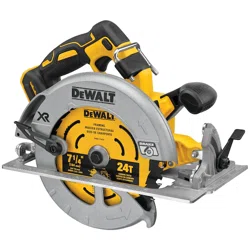Loading ...
Loading ...
Loading ...

English
11
To Replace the Blade (Fig. H, I)
1. To loosen the blade clamping screw
8
, depress the
blade lock button
11
and turn the saw spindle with the
blade wrench
14
until the blade lock engages and the
blade stops rotating. With the blade lock engaged, turn
the blade clamping screw counterclockwise with the
blade wrench (screw has right-hand threads and must
be turned counterclockwise toloosen).
2. Remove the blade clamping screw
8
and outer clamp
washer
17
only. Remove oldblade.
3. Clean any sawdust that may have accumulated in the
guard or clamp washer area and check the condition
and operation of the lower blade guard as previously
outlined. Do not lubricate thisarea.
4. Select the proper blade for the application (see
Blades). Always use blades that are the correct size
(diameter) with the proper size and shape center hole
for mounting on the saw spindle. Always assure that the
maximum recommended speed (rpm) on the saw blade
meets or exceeds the speed (rpm) of thesaw.
5. Follow steps 2 through 5 under To Install the
Blade, making sure that the blade will rotate in the
properdirection.
Lower Blade Guard
WARNING: The lower blade guard is a safety
feature which reduces the risk of serious
personal injury. Never use the saw if the lower
blade guard is missing, damaged, misassembled
or not working properly. Do not rely on the
lower blade guard to protect you under all
circumstances. Your safety depends on following
all warnings and precautions as well as proper
operation of the saw. Check lower blade guard
for proper closing before each use as outlined
in Further safety instructions for All saws.
If the lower blade guard is missing or not
working properly, have the saw serviced before
using. To assure product safety and reliability,
repair, maintenance and adjustment should
be performed by an authorized service center
or other qualified service organization, always
using identical replacementparts.
Blades
WARNING: To minimize the risk of eye injury, always
use eye protection. Carbide is a hard but brittle
material. Foreign objects in the workpiece such as wire
or nails can cause tips to crack or break. Only operate
saw when proper saw blade guard is in place. Mount
blade securely in proper rotation direction before
using, and always use a clean, sharp blade.
WARNING: Do not cut metal, plastic, concrete,
masonry or fiber cement materials with thissaw.
Do not use abrasive wheels or blades. A dull blade will
cause slow inefficient cutting, overload on the saw motor,
excessive splintering, and could increase the possibility of
kickback. Please refer to the table below to determine the
correct size replacement blade for your modelsaw.
RECOMMEnDED BlADE TYPEs
Combination Framing 5/8" Round arbor, 24 teeth
All purpose fast rip and
crosscuts.
Pressure Treated/Wet
Lumber
5/8" Round arbor, 20 teeth
Coated, resistant to gum
build-up.
Extreme Durability 5/8" Round arbor, 18 teeth
Coated, rock carbide.
Finishing 5/8" Round arbor, 36 teeth
More teeth for finer finishcuts.
Fast Cut Framing 5/8" round arbor, 18 teeth
Fastest blade for rips and
crosscuts.
If you need assistance regarding blades, please call
1–800–4-D
E
WALT (1–800–433–9258).
Kickback
Kickback is a sudden reaction to a pinched, bound or
misaligned saw blade, causing an uncontrolled saw to lift
up and out of the workpiece toward the operator. When
the blade is pinched or bound tightly by the kerf closing
down, the blade stalls and the motor reaction drives the
unit rapidly back toward the operator. If the blade becomes
twisted or misaligned in the cut, the teeth at the back
edge of the blade can dig into the top surface of the wood
causing the blade to climb out of the kerf and jump back
toward theoperator.
Kickback is more likely to occur when any of the following
conditionsexists.
1. iMPROPER WORKPiECE sUPPORT
a. Sagging or improper lifting of the cut off piece can
cause pinching of the blade and lead tokickback.
b. Cutting through material supported at the outer ends
only can cause kickback. As the material weakens it
sags, closing down the kerf and pinching the blade
(Fig.Q).
c. Cutting off a cantilevered or overhanging piece of
material from the bottom up in a vertical direction
can cause kickback. The falling cut off piece can
pinch theblade.
d. Cutting off long narrow strips (as in ripping) can
cause kickback. The cut off strip can sag or twist
closing the kerf and pinching theblade.
e. Snagging the lower guard on a surface below the
material being cut momentarily reduces operator
control. The saw can lift partially out of the cut
increasing the chance of bladetwist.
2. iMPROPER DEPTh OF CUT sETTing On sAW
a. To make the most efficient cut, the blade should
protrude only far enough to expose one-half of a
tooth as shown in FigureK. This allows the shoe
to support the blade and minimizes twisting and
Loading ...
Loading ...
Loading ...
